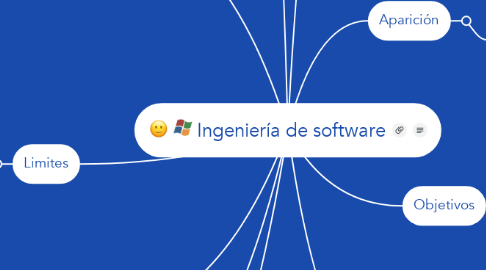
1. Reseña personal
1.1. En la llegada del software era obvio, que era algo innovador, algo que no se podía predecir tan fácilmente. Algo curioso fue que se conoció como "INGENIERÍA DE SOFTWARE" 10 años después, o sea en 1950.
2. Recursos
2.1. Recursos humanos
2.1.1. Es la persona que interactua con con el sistema, ya sea ingeniero, programador, diseñador, etc.
2.2. Recursos de entorno
2.2.1. Son las herramientas con las que el ingeniero, programador, diseñador trabajan, ya sea PC, modelos, programas compiladores, etc.
3. Implicaciones socioeconómicas
3.1. Economicamente
3.1.1. Es una fuerte entrada económica para muchos países, en el caso de USA es una octava parte de su economía.
3.2. Socialmente
3.2.1. El software cambio totalmente la cultura que tenían hace varios años, ahora interactuamos totalmente diferente a hace 50 años.
4. Limites
4.1. El software a pesar de que es un gran imitador de nuestra vida cotidiana, o sea imita al ser humano, tiene la ligera desventaja de trabajar bajo normas, he ahí el limite.
5. Programador VS Ingeniero de software
5.1. Ingeniero de sorftware
5.1.1. Tiene el control total del proyecto
5.1.2. Se encarga de la economia
5.1.3. Se encarga de la calidad
5.1.4. Tiene mayor peso de responsabilidad
5.1.5. Dirige a su personal
5.1.6. Es el líder del grupo
5.2. Programador
5.2.1. Se encarga de lo que le gusta
5.2.2. El y su creatividad eligen el codigo
5.2.3. Solo se enfoca en programar
5.2.4. No tiene nada que ver con el lado economico del proyecto
5.3. Muchas veces se confunde entre programador con ingeniero de software, por eso elegí establecer diferencias.
6. Sin duda alguna, el software cambio la vida de todos a como la conocíamos.
7. Aparición
7.1. Apareció por primera vez en la decada de 1940
8. Objetivos
8.1. Mejorar el diseño de aplicaciones
8.1.1. Situational Analysis / Drivers
8.1.1.1. What is driving us to do this?
8.1.1.2. SWOT Analysis
8.1.1.2.1. Strengths
8.1.1.2.2. Weaknesses
8.1.1.2.3. Opportunities
8.1.1.2.4. Threats
8.1.1.3. Customer Findings - What have we learned from customers?
8.1.2. Competitive Analysis
8.1.2.1. Do we have competitors and threats in these target markets with the proposed offerings?
8.1.2.2. What are our competitors doing and how are they positioning?
8.1.2.3. How do we position against each competitor?
8.1.3. Target Customer(s)
8.1.3.1. Buyer Profile
8.1.3.1.1. Title
8.1.3.1.2. Industry
8.1.3.1.3. Geography
8.1.3.1.4. Business Size
8.1.3.2. Influencer Profile
8.1.3.3. User Profile
8.1.3.4. What do customers want and need?
8.1.3.5. What business problems do each of these customers have?
8.1.4. Customer Segmentation
8.1.4.1. Which customers or sets of customers do we sell to?
8.1.4.2. What are the target market segments that we want to go after?
8.1.4.3. What are the distinct problems for each segment of the market?
8.1.5. Total Available Market
8.1.5.1. New Prospects
8.1.5.1.1. How much of each target segment have we penetrated?
8.1.5.1.2. How much opportunity is available in each target segment?
8.1.5.2. Existing Customers
8.1.5.2.1. Can we up-sell existing customers?
8.2. Promover mayor calidad
8.2.1. Service Offer
8.2.1.1. What are we selling?
8.2.1.2. Product Definition
8.2.1.3. Pricing
8.2.1.4. Packaging
8.2.1.5. Positioning
8.2.2. Value Proposition
8.2.2.1. What is the Value Proposition to the Customer?
8.2.2.2. What pain are we solving?
8.3. Brindar mayor exactitud
8.3.1. Revenue Forecasts
8.3.1.1. Revenue and P&L Forecast (5 Years)
8.3.1.2. Revenue should be split out quarterly
8.3.2. Cost Analysis
8.3.2.1. Should include a description of the costs in entering this business and profitability analysis
8.3.3. Profitability Analysis
8.3.3.1. P&L for the offer to include gross margin, net income and break even analysis.
8.4. Aumentar eficiencia
8.4.1. Sales Strategy
8.4.1.1. Direct Sales Strategy
8.4.1.2. Inside Sales Strategy
8.4.1.3. Channel Sales Strategy
8.4.2. Partner Strategy
8.4.2.1. Channel Strategy
8.4.2.1.1. What 3rd party channels should we consider for reselling this service?
8.4.2.2. Technology Partnerships
8.4.2.2.1. What technology vendors (if any) do we need to work with to execute on this plan?
8.4.2.3. Solutions Partners
8.5. Mejor organización
8.5.1. Positioning & Messaging
8.5.1.1. What is the key messaging and positioning for the service offer? (Pain, alternatives, solution)
8.5.1.2. How do we communicate internally?
8.5.1.3. How do we communicate externally?
8.5.2. Promotion Strategy
8.5.2.1. Marketing Programs (Installed base versus new prospects)
8.5.2.2. Advertising (Publications, etc.)
8.5.2.3. Analyst Relations (Target Analysts)
8.5.2.4. Public Relations
8.5.2.5. Events (Trade shows, SEO/SEA, Seminars)
8.5.2.6. Webinars
8.5.3. Demand Generation & Lead Qualification
8.5.3.1. How do we generate and qualify new leads for the target offer?
8.5.3.2. Prospect Lists
8.5.3.3. Key Questions to Ask
8.5.3.4. Sales Collateral
8.5.3.5. Presentations
8.5.3.6. Data Sheets
8.5.3.7. White Papers
8.5.3.8. ROI Tools
8.5.3.9. Other Sales Tools (web site, etc.)
8.6. Detectar problemas rapidamente
8.6.1. Numbers, budget, waterfall, break-even (cost>leads>trials>deals)
8.6.2. Sales Programs
8.6.3. Accelerated Learning Strategy, Controls, Metrics
8.6.4. Include feedback loops
8.6.5. Include financial metrics (definition of success)
8.6.6. Pipeline reports, etc…

